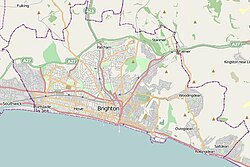St Helen's Church, Hangleton
| St Helen's Church | |
|---|---|

The church from the southwest
|
|
|
Location of St Helen's within Brighton and Hove
|
|
| 50°51′04″N 0°12′03″W / 50.8511°N 0.2009°WCoordinates: 50°51′04″N 0°12′03″W / 50.8511°N 0.2009°W | |
| Denomination | Church of England |
| History | |
| Dedication | St Helen |
| Administration | |
| Parish | Hangleton, St Helen |
| Deanery | Rural Deanery of Hove |
| Archdeaconry | Chichester |
| Diocese | Chichester |
| Province | Canterbury |
St Helen's Church, an Anglican church in the Hangleton area of Hove, is the oldest surviving building in the English city of Brighton and Hove. It is the ancient parish church of Hangleton—an isolated downland village which was abandoned by the Middle Ages and consisted of open farmland until the Interwar period, when extensive residential development took place.
Hangleton existed at the time of the Domesday Book of 1086, although the church was not mentioned; its first known reference is in 1093 when William de Warenne, 2nd Earl of Surrey put it under the control of Lewes Priory. The church stood between the manor house and the cottages and houses of the village to the northeast, and was a rectangular building 62 feet (19 m) long and 17.5 feet (5 m), with flint walls 3.5 feet (1 m) thick. Rebuilding began in the 12th century. The nave dates from that century, while the square tower was added in the 13th century and the church was re-roofed at that time (having originally been thatched). The 12th-century chancel was rebuilt in around 1300.
Hangleton village began to decline in the 14th century. The whole parish, which covered a much wider area than the village itself, had a population of 80 by around 1850. In 1864 it was formally united with the parish of Portslade, having already been administered by Portslade's vicar for the previous 100 years. The condition of the church building worsened, but it never became an unusable ruin and never experienced a period without services—although for a time these were as infrequent as once a year. The churchyard was still used for burials as well.
Unlike many other mediaeval churches in the Brighton and Hove area, which were heavily restored and altered in the 19th century, St Helen's was largely overlooked because of its isolation in a bleak, distant spot high on the South Downs above Hove. In 1870, George Cokayne, later a Clarenceux King of Arms, funded a minor restoration of the church. This may have saved the building from ruin, but also preserved its ancient character.
...
Wikipedia

